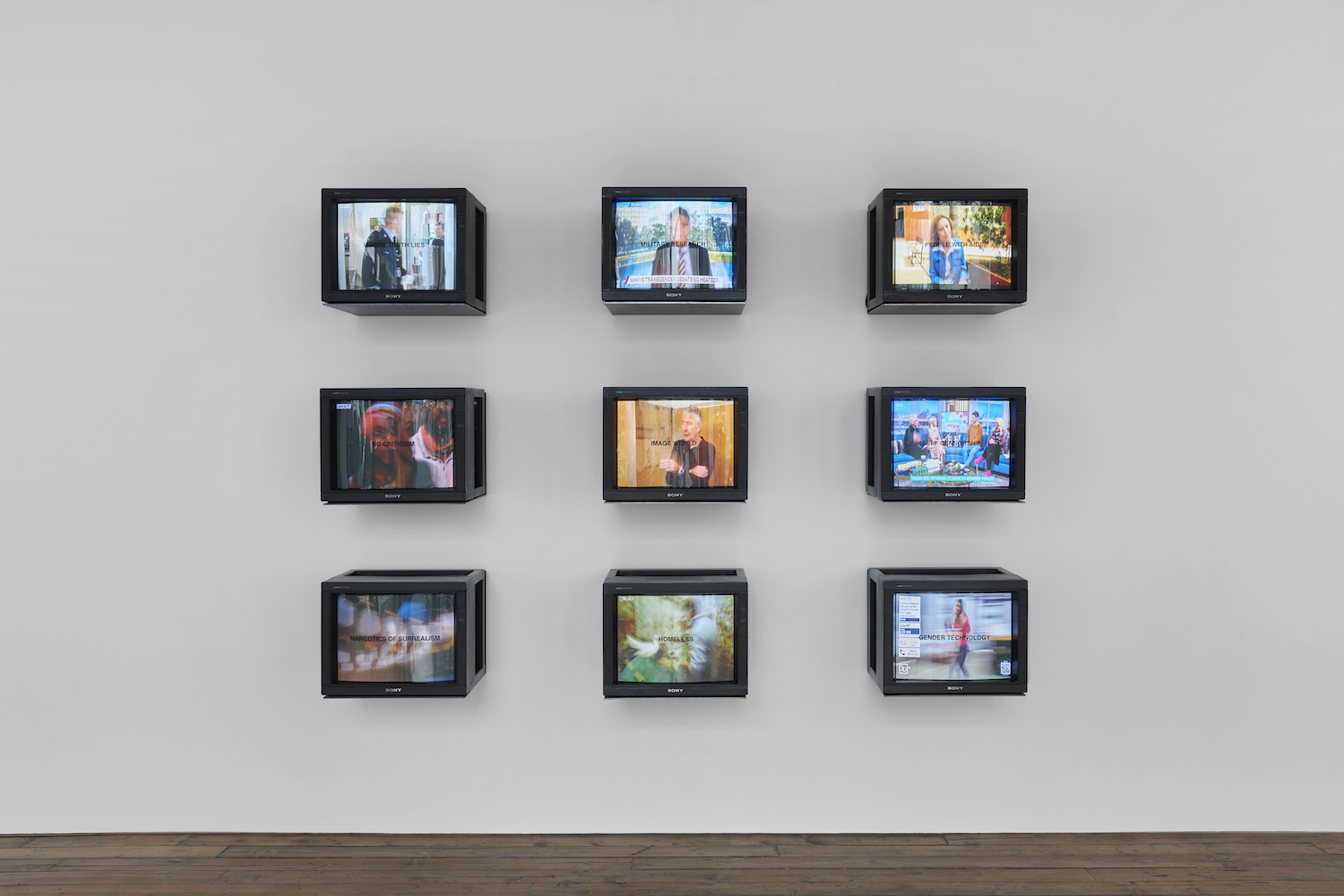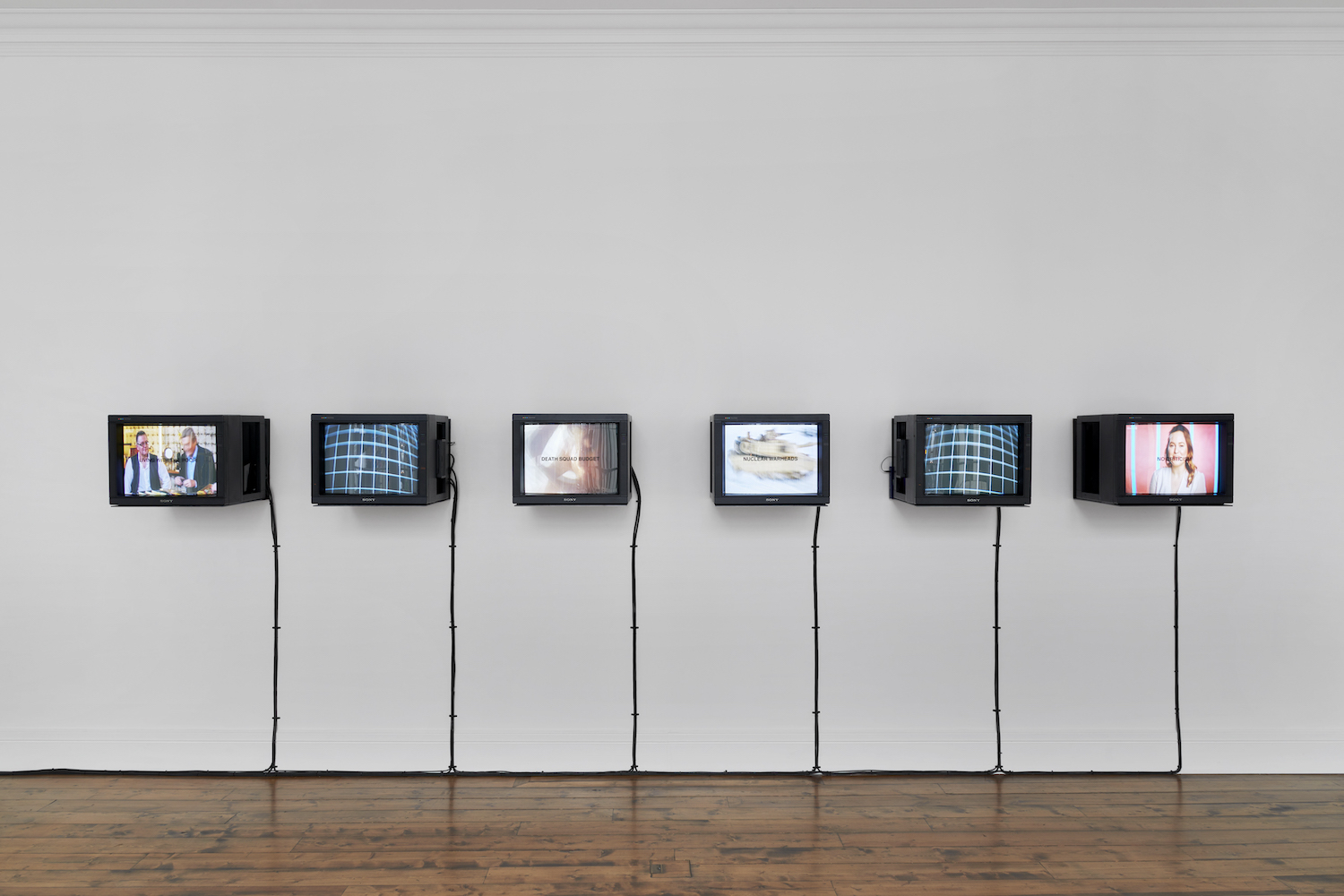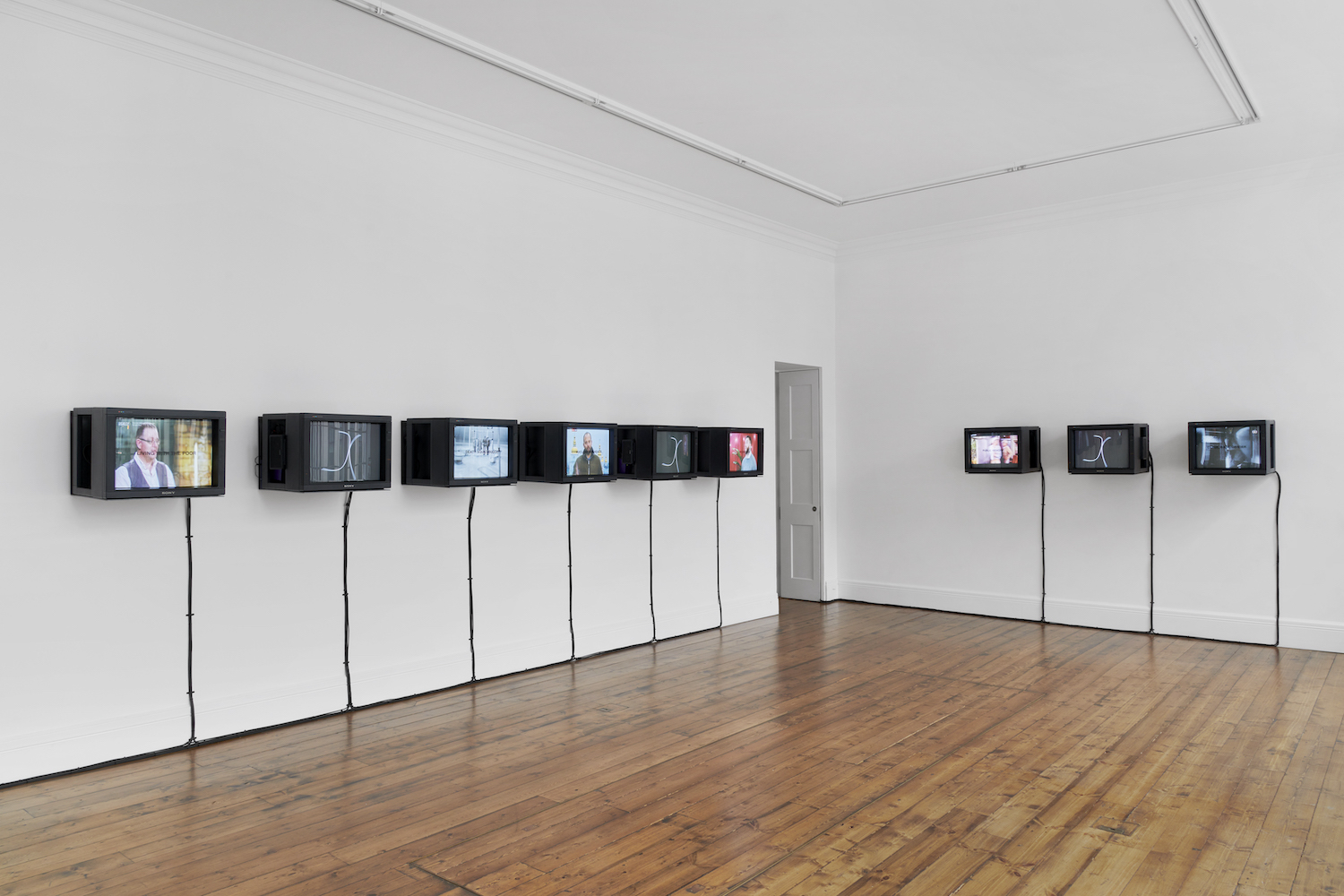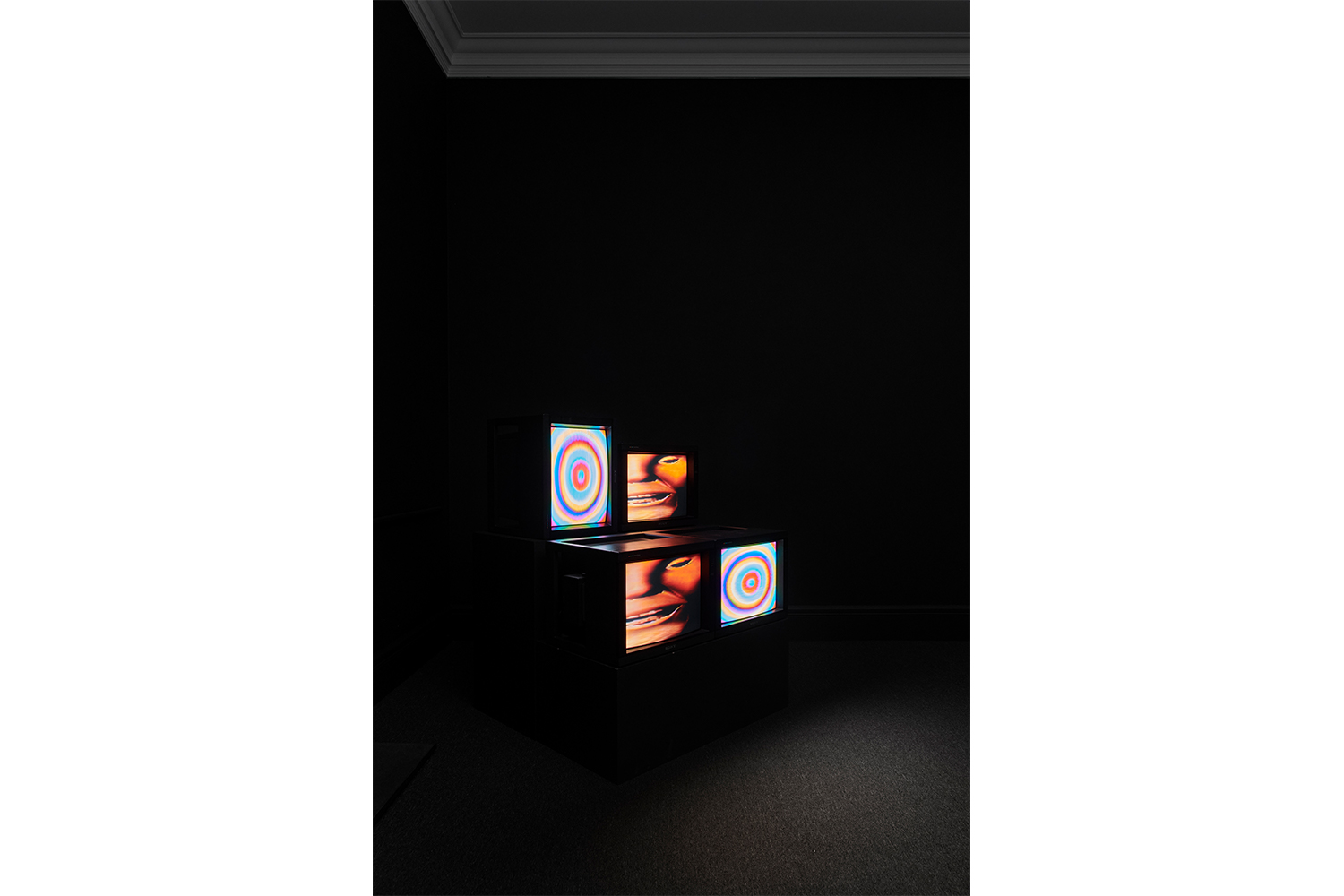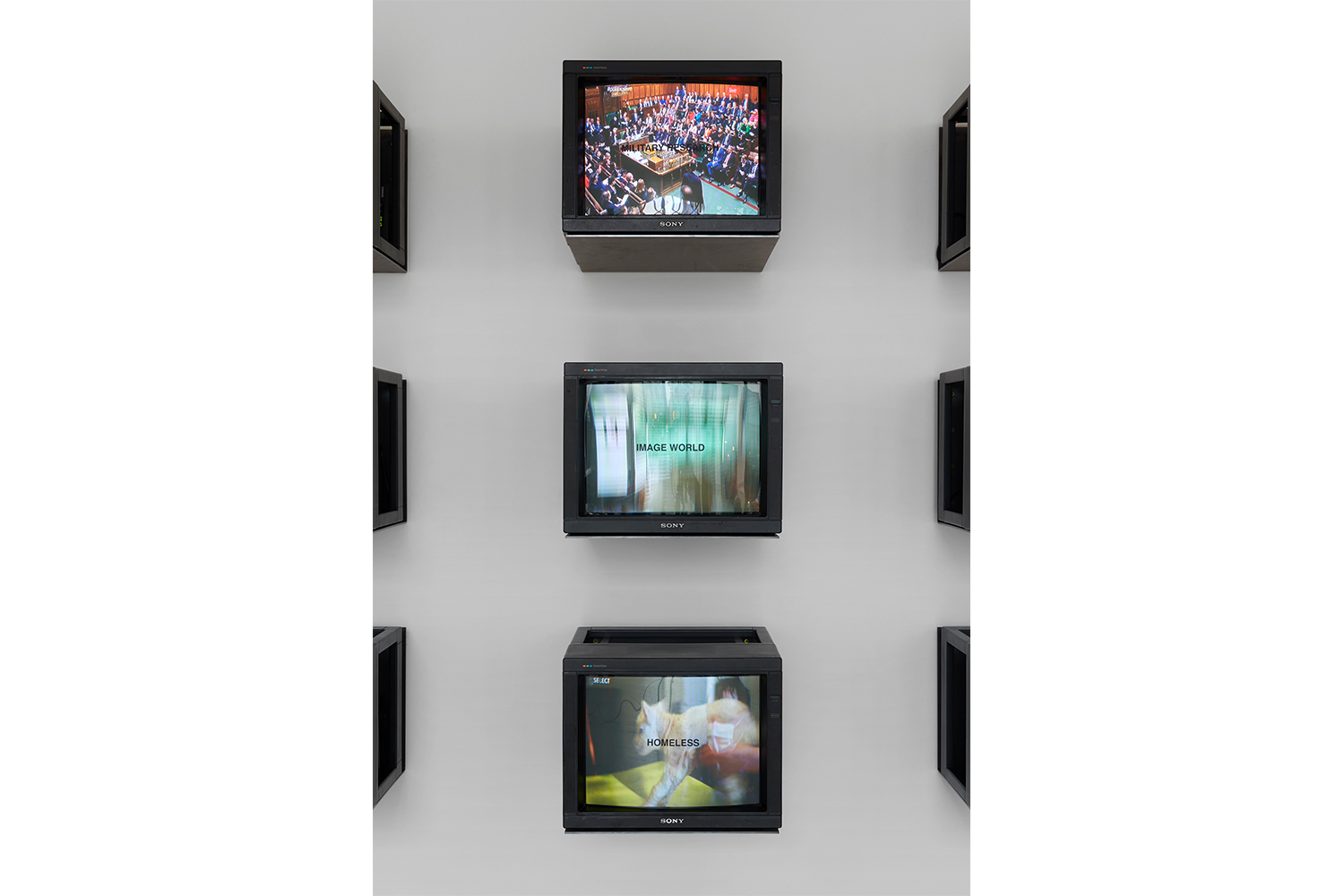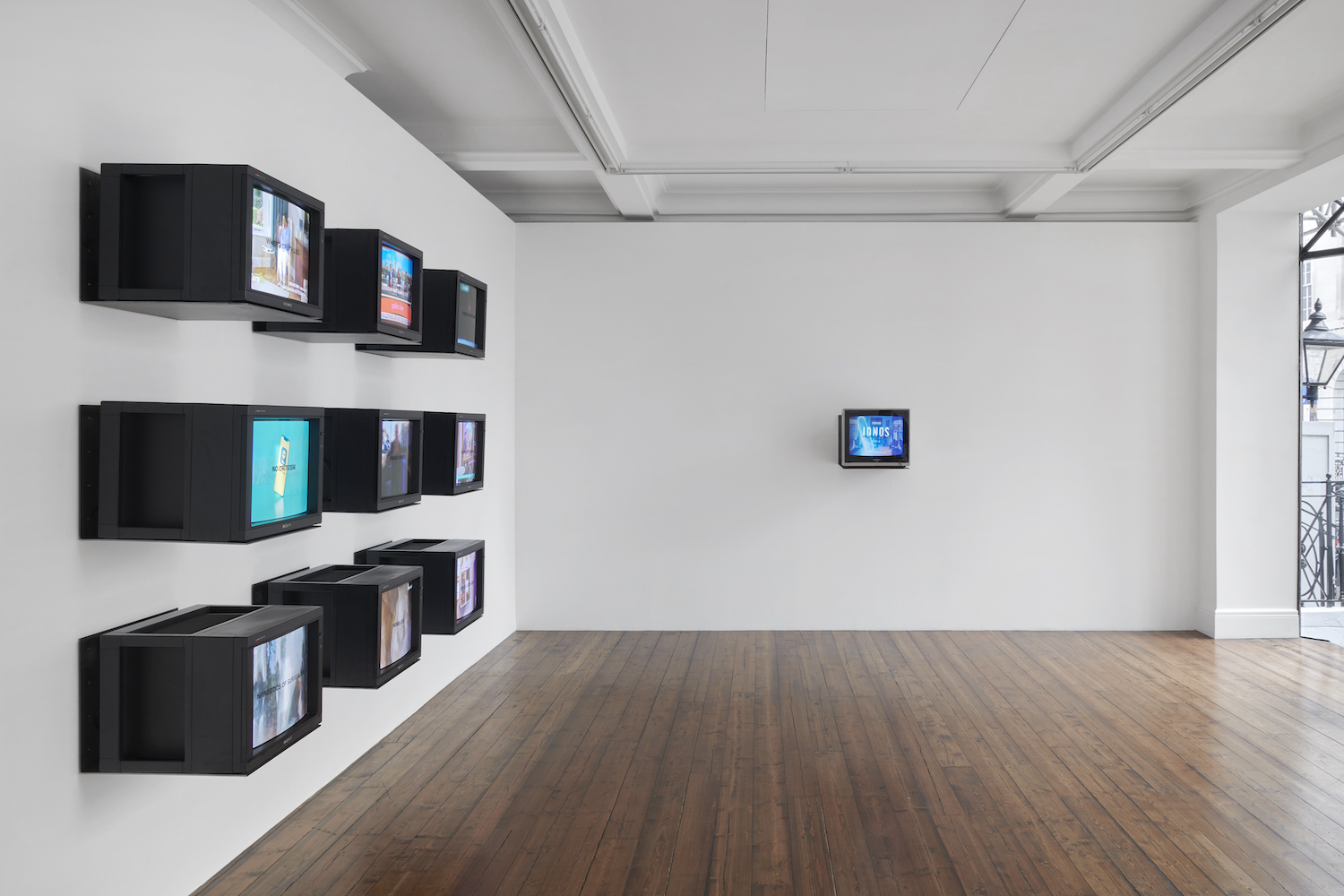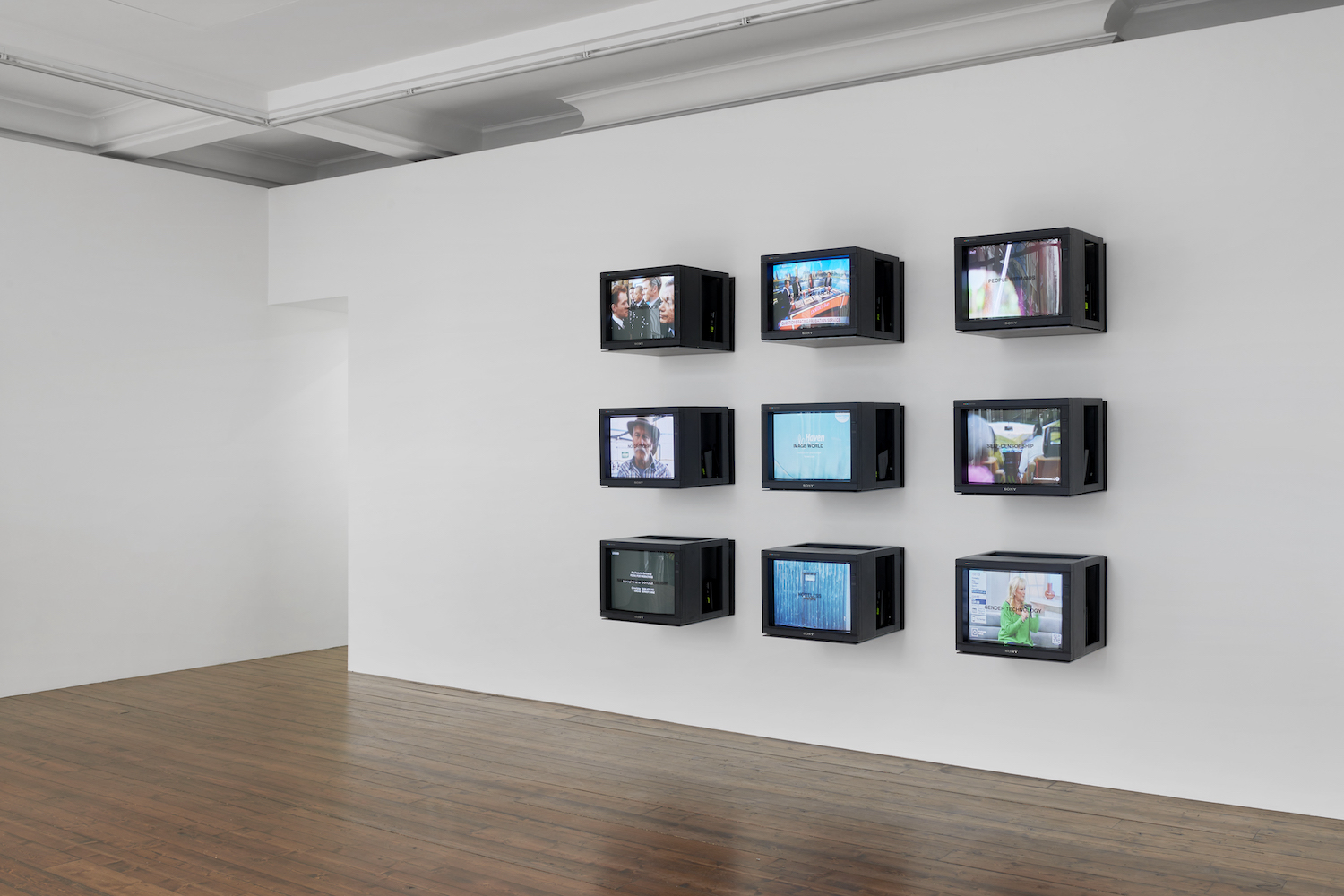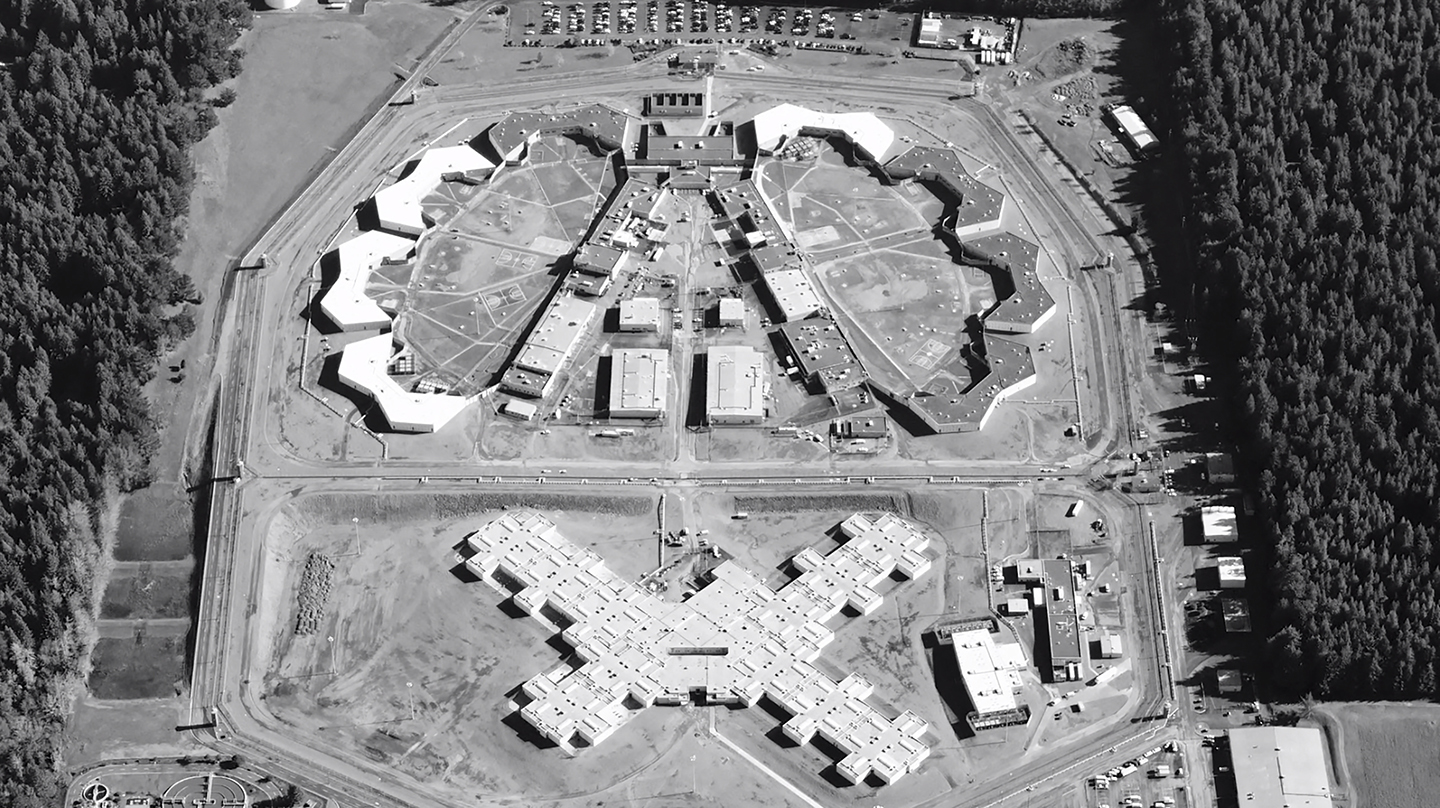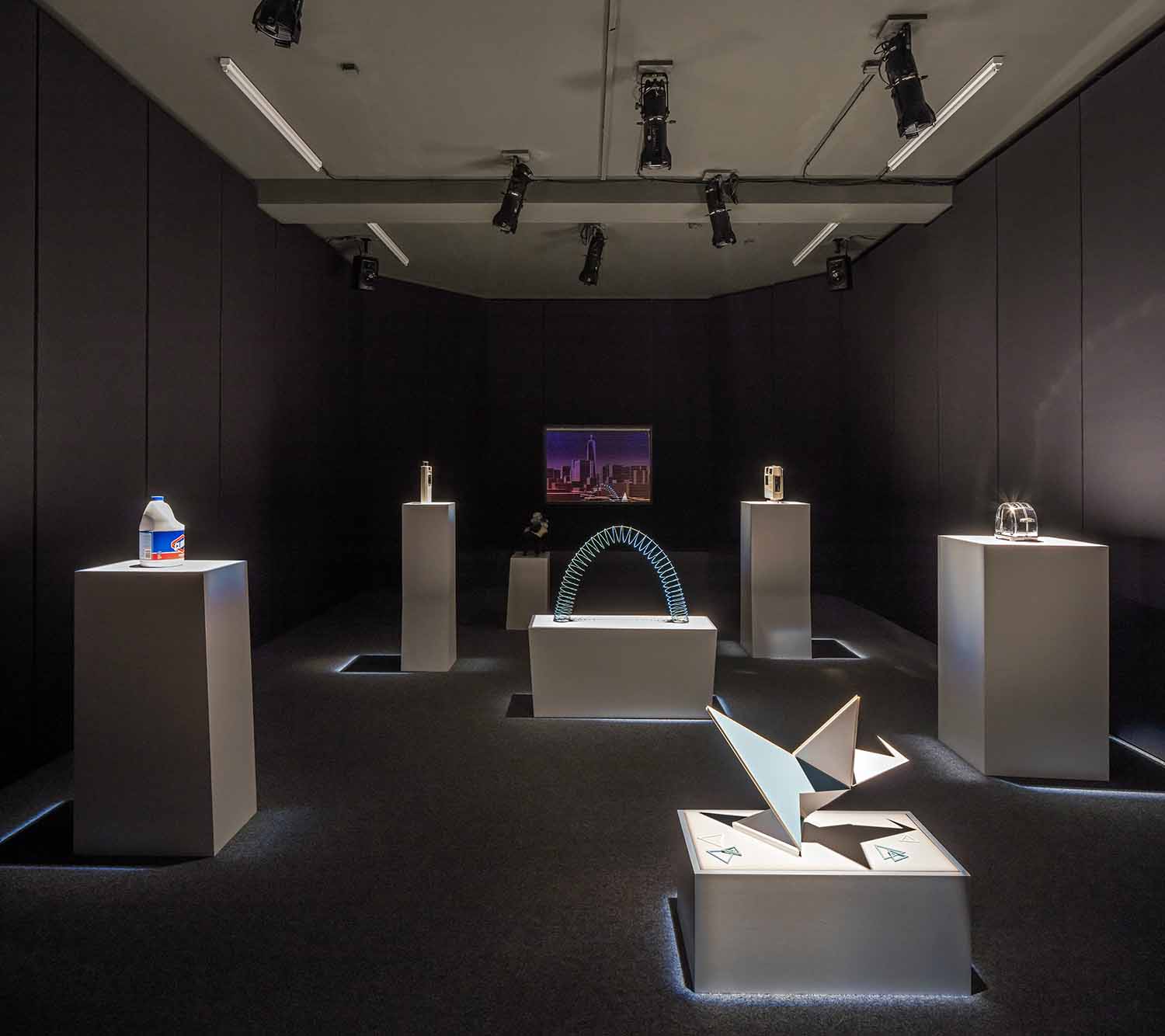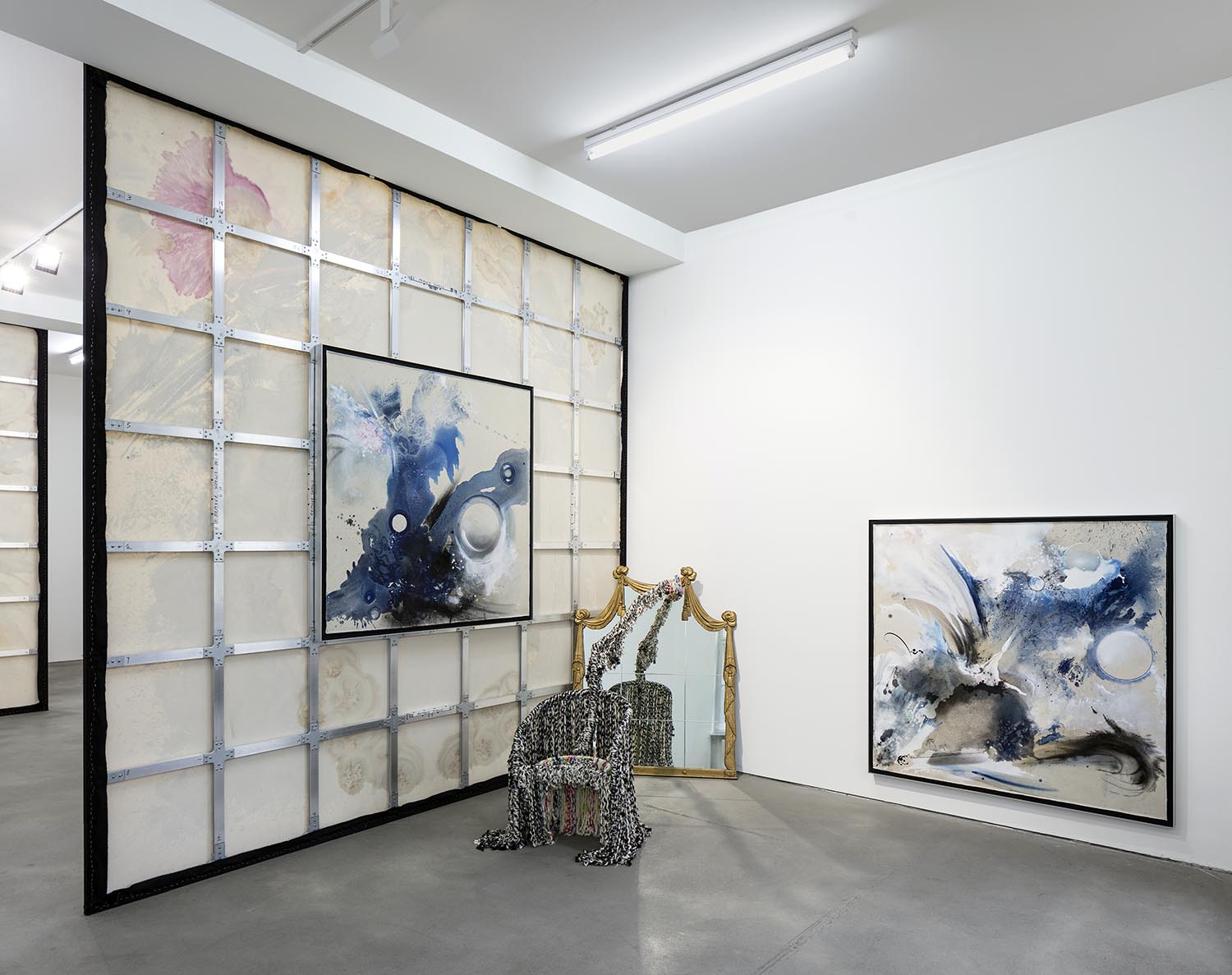Obliquely affiliated with the Pictures Generation of the 1980s, Gretchen Bender’s fierce use of film and television as source material gave the white-hot stealth of her video work a mordacious wash. In conversation with peer Cindy Sherman in 1987, Bender mused on mass media as a “cannibalistic river.” With cyclopean observance she deadpanned: “There is no consciousness or mind. It’s about absorbing and converting.”1
A caustic manifestation of this is evident in Bender’s solo exhibition “Image World,” which begins with her “TV Text & Image” series (1986). A grid of nine television monitors faces the street, and another lone monitor with extended antenna occupies the furthermost wall. Each is respectively keyed to a different channel and live broadcast, every screen overlaid with choice matte-black and all-caps vinyl axioms and phrases such as: GENDER TECHNOLOGY; NARCOTICS OF SURREALISM; MILITARY RESEARCH. The abyssal dehiscence between image and text frustrates any anticipation of syntactical connection, let alone closure. Only fleetingly does the defiant — and literally defying — meta-phraseology relate to the toothless undertow and torrential tedium of its entertainment programming. In such moments the response can perhaps only ever be one of glib acknowledgment: Sunny holiday property programs beneath PEOPLE WITH AIDS? Okay. QVC plugging suet balls arranged in a twee tower beneath GENDER TECHNOLOGY? It is ripe for an apathetic eyeroll. The epic disjunct between issues of significance and the distraction induced by information’s declarative lamination of attention ultimately annihilates itself in equivalency. This is mediascape as non-space, “the flow of the pulse” rippling in the void.
The temporality of “TV Text & Image” adheres to Bender’s knowing acceptance of the works’ anticipatory loss and eventual obviation, that it would “lose [its] strength.” As she expressed further, “My [art] has to do with a temporal limit to its meaningfulness in the culture […] the only constant to the style you develop is the necessity to change it.” This paralysing quality rimes the work — through soporific dystopia does it seldom flex critical bite. The contemporaneity of the live broadcast to which these monitors are tuned could be said to dilute the “now” in which Bender worked; this coverage is arguably symptomatic of differentiated consumption and viewership, however slight. Whether one invests in questioning this relevance of content — its particularity in time — depends perhaps on a willingness to reconcile the overarching risk and inherent nihilism of diminished potency. Bender’s tolerance for loss is not a confession but a readily discerned obsolescence of material, from which the work pivots and becomes elastic, to a point of consensual eclipse.
This oscillation between numbing compliance and critical awareness continues upstairs with another phalanx of wall-mounted monitors, Aggressive Witness – Active Participant (1990). They continue the live television streams of “TV Text & Image” across three walls, with four monitors interjecting the flow of media with undulant grids and interlocking geometries of computer-generated imagery. Most intrusive, however, is Bender’s collaboration with musician Stuart Argabright, whose soundtrack saturates the space in glitchy scintillation, mangled chords, and electro-avian susurration. The final room displays one of Bender’s earliest multichannel video works, Wild Dead I, II, III (Danceteria Version) (1984), comprising four stacked monitors, with one tipped to a portrait orientation. Here the viewer is afforded Bender’s conviction through editing techniques and the pitch of her stylistic voltage: blunt cuts and side-sweeps; shimmering pixels whipped and roiling like bizarre starlings; it is a transfixing symphony of bitter, ensorcelling neon. Gunshots proliferate in stammering brutality, smothered by shattering, sheeny synths in a soundtrack by Argabright and Michael Diekmann. Bender’s visuals meanwhile coruscate from corporate idents — such as AT&T’s telecommunications logo, which Bender equated to the Death Star — to computer-generated graphics of distorted faces, rotating dice, splitting cells, strobing stars, and appropriated imagery including news coverage of military violence. Immured like rarefied noctiluca or sliced geodes, these TVs are glitzy shells dramatizing media’s narcotic visualizations with Bender’s surgical editing amplifying the violence of homogenizing logics.
Bender credits herself for “TV” in Wild Dead, and throughout her career she was clear to explicate her medium as television itself. But her letting go into time is especially resonant. History here does not accrue; it cascades into oblivion feeding its own time loop. In the hollow knowingness of “TV Text & Image,” injected with meaning by mere coincidence, Bender’s legacy is clearly prescient of technocapitalism’s blatant suspension of subjecthood. Where information embroils attention and exhaustion, and everyday life is intuited by the conditioning of digital prophecy: strategic subjectivation of targeted advertisements, suggested searches, systemic algorithmic prediction, and the metabolising of personal data. Artificial intelligence interflowing data patterns and consciousness, images as constitutive forces of subjectivity, surveillance capitalism’s protean absorption — one is annexed to the realm of speculation to wonder how Bender would respond to such an embodied image world, of yet more hysterical depletion.


